The list of the most beautiful buildings in the world has been updated several times. Thus, apart from the ancients, we have architectural marvels of modernity and the present day. But which places ended up in this first countdown? And why are there only seven?
Over the centuries, many civilizations have built beautiful architectural structures. Each of them had a great history, each was erected with difficulty and each had a very specific purpose. Today, we have the knowledge and technology to quickly and efficiently implement even the most advanced projects. Nevertheless, places from the original list of the seven wonders of the world are still delightful.
Lucky seven
Seven. Why not five or ten? It is worth quoting the meaning of this figure; it has magical powers for many peoples and civilizations. It is considered a symbol of completeness, wholeness, time and perfection. From the earliest times, it appears in a certain symbolic "code". Thus there are paintings of seven bulls in the cave of Lascaux, and the first Sumerian ziggurats were seven stories high. The Seven accompanied the Sumerians at every turn:they professed seven divine laws, they had seven sages, seven winds, seven demons, and seven gates led to the underground realm of Kur.
It was the same with the Egyptians. The mummification of the corpse took seventy days, using seven oils. The main gods - Re and Osiris - were surrounded by seven deities, and the pyramid of Djoser in Saqqara has seven floors. There are many examples.
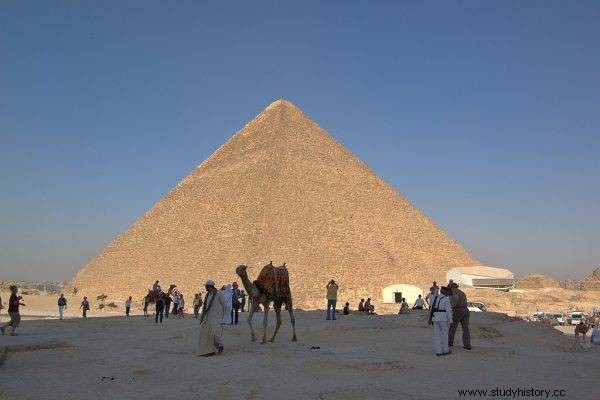
Great Pyramid of Cheops
With the Greeks there were seven muses and seven cities of Homer, with the Romans - as many hills on which their capital was built, the Persians divided the world into seven spheres, the Hebrews distinguished seven days of the week, the Chinese believed that the soul leaves the body seven weeks after death ... Culture and religion can find at least one example related to the number seven.
No wonder then that also included only seven items on the list of architectural wonders of the ancient world. Interestingly, the counting out we know today was completed only in the Middle Ages, when most of the objects did not exist anymore.
The original list was compiled by the Greek poet Antipater of Sidon in the 2nd century B.C.E. and included the Ishtar Gate (instead of the Pharos Lighthouse) and the statue of Asclepius in Epidaurus and the Colossi of Memnon (it was used until around the 6th century CE). The medieval one refers to it in a way, because it is derived from Greek stories, and the places it describes were known to the ancient Greeks. What hit her?
Pyramid of Cheops
The most famous of the Egyptian pyramids was built around 2500 BC. on the Giza plateau. It was a tomb prepared for Pharaoh Khufu (Egypt. Chu-fu). Construction probably took about 20 years. The area on which the pyramid was to be built was artificially leveled, and the body itself was made with the greatest precision (the sides of the pyramid are positioned with an accuracy of four angular minutes perfectly with respect to the sides of the world) . The blocks used in the construction weighed from 2 to even 80 tons, and in total they were used ... over 2 million!
Initially, the pyramid was covered from the outside with a smooth layer of limestone, and with the pyramidion crowning the whole, its height was 146 meters (today it is less than 139 meters). It was robbed of all its treasures in antiquity and lost its veneer in the Middle Ages. The impact of erosion is unfortunately inevitable.
The pyramid is the only surviving object on the list of the seven wonders of the ancient world. Although it does not look as beautiful as it did in its heyday, it still delights, igniting the imagination.
Temple of Artemis in Ephesus
Artemision is a temple built around 550 BC. by order of King Croesus (ruler of Lydia, a historical land in Asia Minor). It was designed by Metagenes and Chersifron of Knossos and Theodoros of Samos as dipteros . Built in honor of Artemis (her cult was very popular in Ephesus), the goddess who looked after the earth, gave life and prosperity. Every year in May, Ionia celebrated a festival in her honor.
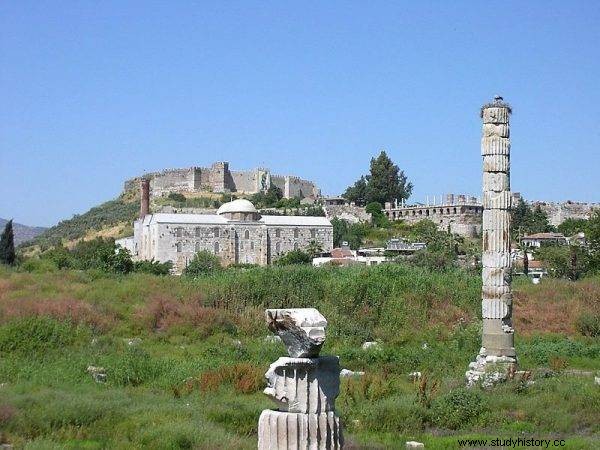
Ruins of the Temple of Artemis in Ephesus
Inside the temple was a statue of Artemis made of gold, silver, ebony, ivory, and black stone. Unfortunately, it has not survived to this day. The building itself was also destroyed - for the first time as a result of burning, and then as a result of the Goths' invasion. It has never been restored.
At the end of the 19th century, the archaeological work carried out by a team of British researchers made it possible to pinpoint where it was located. Currently, we can see several elements of this building on display at the British Museum.
The Hanging Gardens of Babylon in Babylon
They were erected by order of King Nebuchadnezzar II (around 600 BCE), who wanted to pass them on to his wife Amytis, because after moving to Babylon from Media, an ancient country in what is now western Iran, she longed for lush greenery. They were named after the Assyrian queen Semiramis.
They are mentioned in many texts - incl. in Herodotus, Strabo or Diodorus Sicily, so despite many controversies it is assumed that they existed. Built on terraces that provided perfect hydration, they were supposed to appear to be floating in the air. It was damaged by an earthquake in the 1st century BC.
Faros Lighthouse
Built around 280 B.C.E. according to the design of Sostratos, it was ordered by the ruler of Egypt, Ptolemy I. The construction of this structure lasted from 15 to 20 years.
It was a tower about 120 meters high. A smaller storey rose on a square, wide base. Closer to the top, the lantern turned into a circle crowned with a dome, under which was a statue of Poseidon. At that time it was the tallest building in the world, and its description has been preserved thanks to the accounts of travelers and representations on coins.
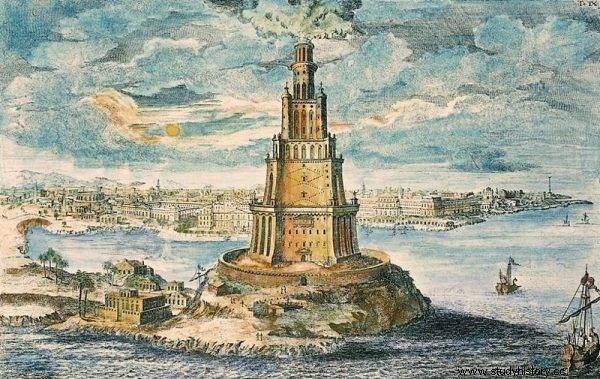
Faros lighthouse
Unfortunately, it was damaged during several earthquakes (although repair work was carried out). In the 2nd century CE the upper part of the building collapsed, and from the 9th century, the lower floors were converted into a mosque. In the 13th and 14th centuries, the lighthouse was completely destroyed. It was never fully rebuilt, although a fort was built on its foundations in the 15th century (now the Maritime Museum is located here).
Colossus of Rhodes
It was a huge statue of the god Helios (Greek sun god) erected by Chares of Lindos in 294-282 BC. It was located on the shores of the island of Rhodes (at the entrance to the port). It was made of bronze in memory of the failure of Demetruisz Polioketes to conquer the city. The statue was about 30 meters tall and stood on a pedestal and took 12 years to build.
Although most of us know the representations of the Colossus of Rhodes straddling (ships were supposed to pass underneath it), erecting such a building at that time was rather impossible for technical reasons. The statue probably stood near the entrance to the port (or on the hill where the castle stands today) on the aforementioned pedestal, measuring about 10 meters.
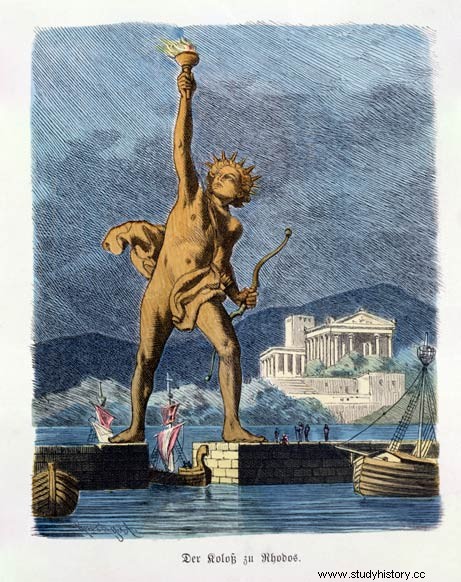
photo:Ferdinand Knab / public domain Kolos Rodyjski
At the turn of 227 and 226 BCE the island was struck by an earthquake that destroyed the Colossus. The statue had not been rebuilt (the oracle at Delphi opposed it), but its remains were still lying near the place where it once proudly stood. In the 7th century, the Arabs seized Rhodes and sold the parts of the Colossus to a traveling merchant (according to Theophanes the Confessor - a Byzantine clergyman and historian - as many as 900 camels were needed to remove them).
Mausoleum at Halicarnassus
It was the tomb of the Persian satrap Mausolus, built around 350 BCE. It was designed by Satyros and Pyteos at the behest of Queen Artemisia (the widow of the Mausolus). The city of Halicarnassus was then the capital of a regional kingdom in the Achaemenid Empire.
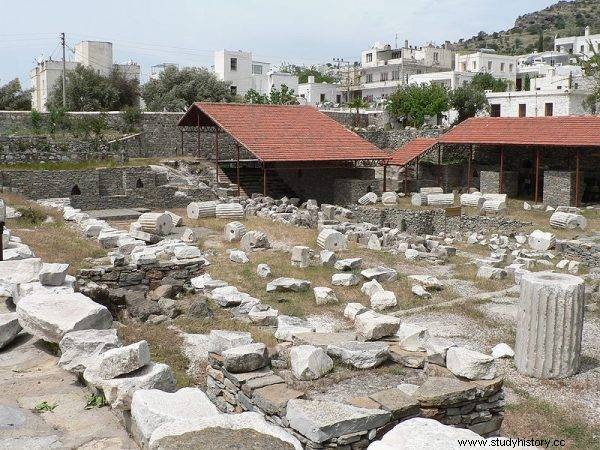
The remains of the mausoleum
The mausoleum was 45 meters high, its base was a rectangle measuring 35 by 25 meters. It was an Ionian temple with a colonnade of 40 columns and a pyramid with a quadriga (horse-drawn cart) at the top with the image of the ruler and his wife.
The building has not survived to our times; for many years it was neglected, stolen by people and exposed to earthquakes. Already in the 15th century, only the foundations remained. However, some elements and monuments can be seen in London today.
Statue of Zeus at Olympia
This statue was made by Phidias (Greek sculptor, the most prominent representative of the classical period) in the 5th century BC. and was in the temple of Zeus at Olympia.
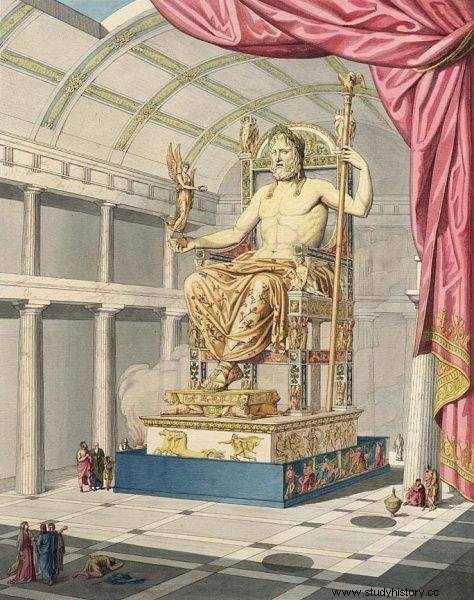
Image of the statue of Zeus
Zeus was presented on the throne. In one hand he held a statue of the goddess Nike, in the other a scepter inlaid with precious stones. He had a wreath of olive branches on his head, and a golden cloak hung from his left shoulder. The throne was also decorated - with battle scenes and deities. Most of the elements were made of gold, ivory, cedar wood and precious stones.
The huge statue stood in the temple for less than eight centuries. At the beginning of the 5th century CE he was deported to Constantinople. In 475, the sculpture was destroyed by a fire. The only depictions of the statue are those from the reverse of the coins, however, a lot of literary descriptions have also survived, e.g. by Pausaniasz or Strabo.
Bibliography:
- Ceram C. W., Gods, Tombs, and Scholars , Warsaw 2002.
- D. must have, From Homer to Cleopatra , Warsaw 2008.
- Caselli G., Seven Wonders of the World. Fascinating, famous buildings from the past and today , Warsaw 1990.
- Pharaohs. People, gods, rulers , [In:] Politics Historical Assistant , Warsaw 2008.
- Gööck R., Wonders of the world. Seven wonders of the world, historical wonders, miracles of construction technology, wonders of nature , Warsaw 1998.
- Lengauer W., Ancient Greece of the Archaic and Classical Period , Warsaw 1990.
- Majdecki L., Majdecka - Strzeżek A., History of gardens. From antiquity to the baroque , vol. 1., Warsaw 2008.
- The Seven Wonders of the Ancient World , under. Edited by Clayton P. A, Price M. J., London 1988.
